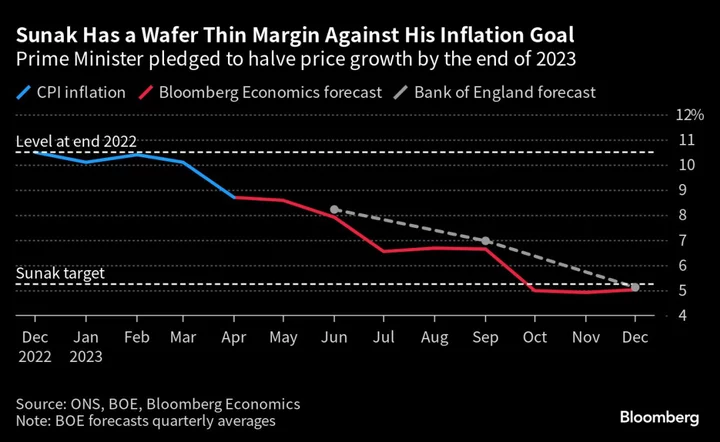British households and businesses are bracing for UK inflation figures on Wednesday that are expected to keep the pressure on the Bank of England to raise interest rates again.
Consumer-price growth is projected to fall from 8.7% in May to 8.2% in June, according to a survey of economists by Bloomberg, its lowest level since March last year. However, core inflation is expected to remain at a 31-year high of 7.1%
Moreover, inflation has exceeded forecasts for four months running. That’s fueling speculation that the fastest monetary-tightening cycle since the 1980s has further to run and driving up the cost of mortgages.
Another upside surprise could tip the balance in favor of a half-point rate increase when the Monetary Policy Committee meets next month to decide how to bring inflation back to its 2% target, economists and investors say. A downside surprise, on the other hand, could relieve pressure on the bank and see traders unwind recent bets on peak UK rates.
“These inflation numbers will prove critical to the BOE’s next decision,” said Michael Saunders, senior adviser at Oxford Economics and a former BOE rate-setter. Anything above 8.2% “would be deeply alarming” and anything below “would be somewhat reassuring.”
Bloomberg Economics, whose inflation forecasts for June are below the survey median at 8%, says core inflation — excluding food, fuel and energy prices — will be crucial.
What Bloomberg Economics says...
“The UK’s June CPI print will determine the size of the Bank of England’s interest rate hike in August. We think core inflation will drop back below 7% year on year, putting a 25-bp move in play. But the strength of the recent wage data means an overshoot of our forecast would make a second consecutive 50-bp hike the most likely outcome at the central bank’s next meeting.”
Dan Hanson and Ana Andrade, Bloomberg Economics. Click here for preview
While economists expect a quarter-point hike in August, markets are almost fully pricing in a half point, with further increases in September, November and December. Traders see rates peaking at 6.25%, their highest level since 1999.
That contrasts with the US, where a sharp slowdown in inflation to just 3% has offered hope that the Federal Reserve can soon wrap up its own rate-tightening cycle.
In June, the BOE jolted markets with a half-point rise to 5%, piling more stress on remortgaging homeowners and giving the government a headache as it heads into a series of crucial special elections Thursday. Prime Minister Rishi Sunak, whose Conservative Party lags far behind the Labour opposition in national opinion polls, has promised to halve inflation by December from the 10.5% seen at end of 2022.
Downward pressures on inflation in June likely came from auto fuel and food prices, which jumped in the same month a year earlier. A big drop in energy bills probably pushed inflation lower again this month. But the BOE has shifted its focus to underlying prices – particularly services inflation which it considers the clearest indicator of domestically generated price pressures.
George Buckley, European economist at Nomura, said the important figure will be the month-on-month services inflation rate, which has been running about 0.7 percentage points above pre-pandemic averages. He expects that to drop to 0.2%. “It is still more than usual and not consistent with the inflation target but would suggest a quarter point hike rather than a half point,” he said.
Recent jobs data provide some evidence that the labor market is easing, with job vacancies dropping and unemployment rising, but wages remained high. The BOE is trying to strike a perfect balance, where it kills enough demand to cool prices but not so much that it causes a recession.

